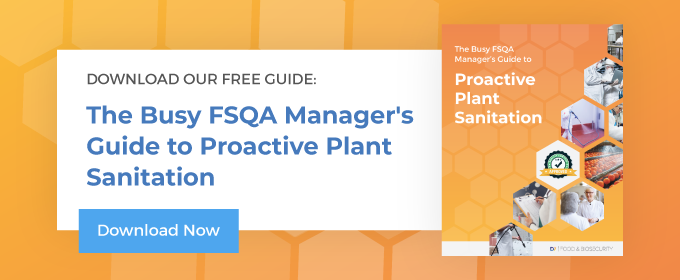
In addition to maintaining safe levels of bacteria in a food processing facility, FSQA managers must also take measures to prevent physical contamination. Any object that is not supposed to be in a food product can qualify as a physical contaminant, no matter how it got there. Whether it’s a piece of an olive pit in a container of hummus or something an employee dropped in a mixing vat, physical contamination presents serious risks to both consumers and food brands.
The Risks of Physical Contamination
When consumers encounter bones, shells, or other sharp objects in their food, it can result in discomfort or injury. This can happen from biting down on a hard object or ingesting something that has the potential to cause harm, require surgery, or even result in death. Brands risk lawsuits and the corresponding financial implications from individuals who have been harmed in this way.
There is also a great risk to the reputation of a brand when a foreign object has been found in a product, especially if that information is widely publicized through modern media channels. According to the FSIS, there were 23 recalls in the U.S. in 2018 due to the presence of extraneous material. Each of these recalls had associated costs to remove products from shelves and inform consumers, not to mention lost sales and inventory.
Types of Physical Contamination
Unwanted physical objects can be introduced to food through three primary methods: naturally, accidentally, or intentionally. Contamination might occur naturally when an insect is found in produce or when bones are left behind in a product that is supposed to be boneless. Accidental contamination might happen when a hair falls into a food product or when a piece of packaging from an ingredient gets added during the food preparation process. Intentional contamination can happen when a disgruntled employee decides to throw something in a food container or if somebody tampers with food after it has been placed on store shelves.
According to Food Safety Magazine, the 12 most common physical contaminants, also known as The Dirty Dozen, are:
-
-
- Metal
- Bullets or BBs
- Needles
- Jewelry
- Stones
- Wood
- Insulation
- Glass
- Insects
- Bone
- Plastic
- Personal effects
-
Regardless of how an object makes its way into a food product, it can present serious risks to both individual consumers and food brands.
How to Prevent Physical Contamination
Accidents happen, and even the best employees can’t find and remove every insect from a crop of broccoli. Although it may not be possible to avoid 100 percent of physical contamination incidents, it is possible to take preventive measures that protect consumers. For example, many production facilities use metal detectors to ensure that no shavings or machine parts contaminated the food being processed.
Creating a culture of food safety will also encourage employees to speak up when accidents happen. When everybody has the same mindset about taking a proactive approach to safety, the risk of physical decontamination decreases.
Physical Contamination Standards
The FDA and other government agencies are continually making recommendations and providing guidance documents for food processors. For example, in February 2020 the FDA released supplemental guidance for mitigation strategies to protect against intentional adulteration to support a previously released rule. The guidance includes taking preventive steps, such as identifying potential vulnerabilities in a facility, developing strategies to mitigate risk, and requiring more rigorous record-keeping.
A Proactive Approach Protects Consumers and Brands
Contamination of all types—physical, chemical, and biological—can have a significant negative impact on a brand, especially if contaminated products make it into the food supply. Prevention is the key to keeping food products safe and protecting your brand. The Busy FSQA Manager’s Guide to Proactive Plant Sanitation offers tips and best practices for keeping a food processing facility clean and sanitized. Download your copy today.

